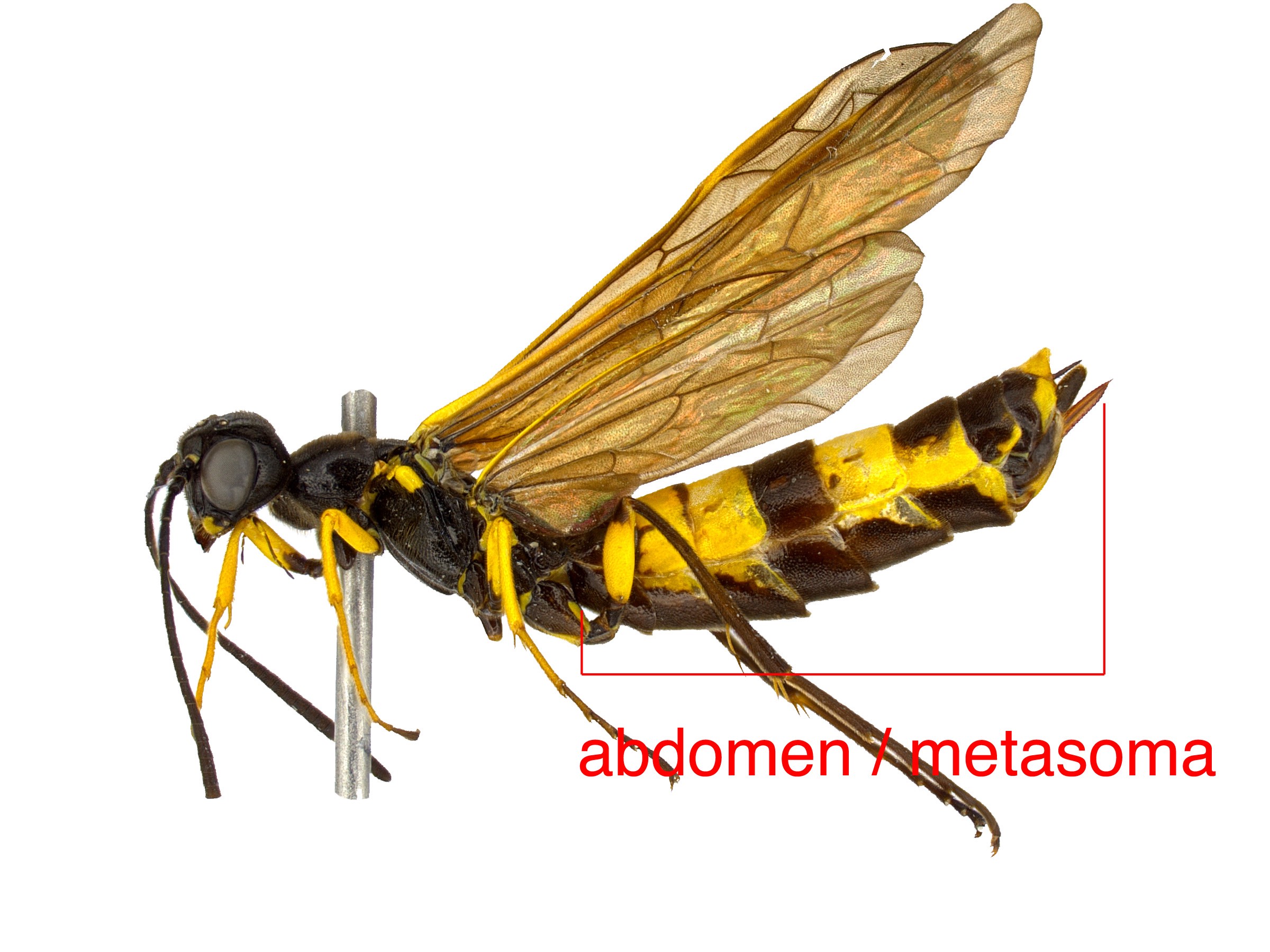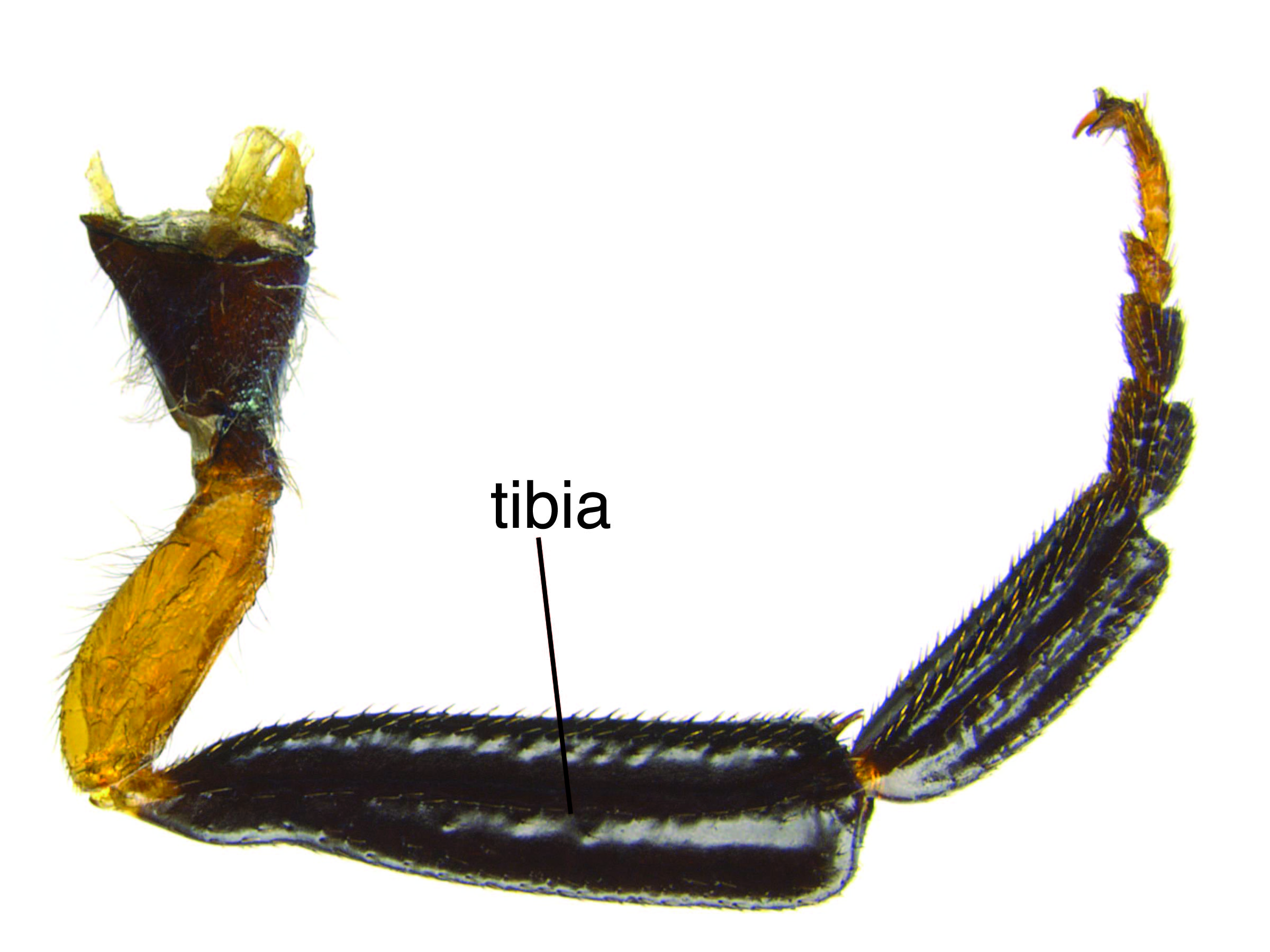Family: Anaxyelidae
Family common name: incense cedar woodwasps
Subfamily: Syntexinae
Genus: Syntexis Rohwer, 1915
Subgenera: none
The Anaxyelidae is largely a fossil family with only one living species. Syntexis libocedrii is a rarely found North American species with a small range and specific larval feeding habits. They are easily recognized by the cylindrical wasp-like body shape and distinctive white markings on the head and abdomenabdomen:
the third and last segment of an insect's body; in sawflies this is usually made up of 11 segments (segments 9 and 10 often fused) (Wickman 1967Wickman 1967:
(Wickman 1967Wickman 1967:
Wickman BE. 1967. Life history of the incense cedar wood wasp, Syntexis libocedrii (Hymenoptera: Syntexidae). Annals of the Entomological Society of America 60 (6): 1291-1295., Goulet 1992Goulet 1992:
Goulet H. 1992. The genera and subgenera of the sawflies of Canada and Alaska: Hymenoptera. Symphyta. The insects and arachnids of Canada. Part 20. Agriculture Canada Publication., Milius 2001Milius 2001:
Milius S. 2001. Why fly into a forest fire? Itrsquo;s one way to meet a lot of great bugs. Science News 159: 140-141.).
There is one described species of Syntexis, restricted to North America (Taeger et al. 2010Taeger et al. 2010:
Taeger A, Blank SM, and Liston AD. 2010. World Catalog of Symphyta (Hymenoptera). Zootaxa 2580: 1-1064.).
 slightly medially constricted and evenly sloping down; not “collar”-like with a distinct anterioranterior:
slightly medially constricted and evenly sloping down; not “collar”-like with a distinct anterioranterior: with 1 apicalapical:
with 1 apicalapical:Syntexis libocedrii can be distinguished from Siricidae by the lack of cornuscornus:
a pointed horn-like process on the apical end of the abdomen in Siricidae sawflies; on tergite 10 in females, sternite 9 in males
 and evenly sloping pronotumpronotum:
and evenly sloping pronotumpronotum:
the anterodorsal part of the thorax, often situated posterior to the head
 shape, from Cephidae by the presence of cenchricenchrus:
shape, from Cephidae by the presence of cenchricenchrus:
a sclerotized eliptical lobe on the metascutum used to provide friction with underside of wings to hold them in place on the dorsum of the body while in rest
 , and from all other families by the equal lengths of the second and third antennal segments (Goulet 1992Goulet 1992:
, and from all other families by the equal lengths of the second and third antennal segments (Goulet 1992Goulet 1992:
Goulet H. 1992. The genera and subgenera of the sawflies of Canada and Alaska: Hymenoptera. Symphyta. The insects and arachnids of Canada. Part 20. Agriculture Canada Publication.).
none
Larvae characteristically feed on the wood of trees of Calocedrus decurrens (incense cedar), and for many years this was the only recorded host. However, S. libocedrii has also been reared from Juniperus occidentalis (western juniper) and been observed ovipositing in Thuja plicata (western red cedar) (Westcott 1971Westcott 1971:
Westcott RL. 1971. New host and distribution records for three western wood-boring Hymenoptera (Syntexidae, Siricidae). The Pan-Pacific Entomologist 47: 310., Smith 1993Smith 1993:
Smith DR. 1993. Systematics, life history, and distribution of sawflies. Pp. 3-32. In: Wagner MR and Raffa KF, eds. Sawfly Life History Adaptations to Woody Plants. University of Minnesota Academic Press. 581 pp., Middlekauff 1974Middlekauff 1974:
Middlekauff WW. 1974. Larva of the wood-boring sawfly Syntexis libocedrii Rohwer (Hymenoptera: Syntexidae). The Pan-Pacific Entomologist 50 (3): 288-290.).
Syntexis libocedrii has a unique life history among sawflies; the preferred oviposition site for this species is wood that has been recently burnt. The female oviposits 1–5 eggs in close proximity at a depth of 1–4 mm in freshly scorched wood pieces. In laboratory settings, females will not deposit eggs into un-burnt wood, further indicating indicating this species is fire-adapted (Wickman 1967Wickman 1967:
Wickman BE. 1967. Life history of the incense cedar wood wasp, Syntexis libocedrii (Hymenoptera: Syntexidae). Annals of the Entomological Society of America 60 (6): 1291-1295., Milius 2001Milius 2001:
Milius S. 2001. Why fly into a forest fire? Itrsquo;s one way to meet a lot of great bugs. Science News 159: 140-141.).
After hatching, the larvaelarva:
the immature stage of holometabolous insects
 immediately begin to bore into the sapwood and create a curved gallery, often U-shaped, on average 50 mm in length. LarvaeLarva:
immediately begin to bore into the sapwood and create a curved gallery, often U-shaped, on average 50 mm in length. LarvaeLarva:
the immature stage of holometabolous insects
 are cylindrical and white with an apicalapical:
are cylindrical and white with an apicalapical:
towards the apex; farthest away from the body
horn-like structure, similar to larval Siricidae. At maturity, the prepupaprepupa:
the active, non-feeding life stage in which the larva prepares to enter the pupal stage
enters a pupal chamber, near the surface of the wood. Adults emerge after diapausediapause:
a non-active period of no development; sawflies often enter diapause as a prepupa or pupa to overwinter
and pupation in summer. Though in a laboratory setting this species had a 1-year life cycle, in the field adults were not observed emerging until the second and third year of development (Wickman 1967Wickman 1967:
Wickman BE. 1967. Life history of the incense cedar wood wasp, Syntexis libocedrii (Hymenoptera: Syntexidae). Annals of the Entomological Society of America 60 (6): 1291-1295., Middlekauff 1974Middlekauff 1974:
Middlekauff WW. 1974. Larva of the wood-boring sawfly Syntexis libocedrii Rohwer (Hymenoptera: Syntexidae). The Pan-Pacific Entomologist 50 (3): 288-290.).
World: This genus is represented only in North America (Taeger et al. 2010Taeger et al. 2010:
Taeger A, Blank SM, and Liston AD. 2010. World Catalog of Symphyta (Hymenoptera). Zootaxa 2580: 1-1064.).
North America: Most Syntexis libocedrii records are from northern California, specifically in the Sierra Nevada and Siskiyou mountain ranges. The species has also been recorded from southern Oregon and British Columbia (Westcott 1971Westcott 1971:
Westcott RL. 1971. New host and distribution records for three western wood-boring Hymenoptera (Syntexidae, Siricidae). The Pan-Pacific Entomologist 47: 310., Goulet 1992Goulet 1992:
Goulet H. 1992. The genera and subgenera of the sawflies of Canada and Alaska: Hymenoptera. Symphyta. The insects and arachnids of Canada. Part 20. Agriculture Canada Publication.). Two records also exist for Idaho, although they are from a bird's stomach (Westcott 1971Westcott 1971:
Westcott RL. 1971. New host and distribution records for three western wood-boring Hymenoptera (Syntexidae, Siricidae). The Pan-Pacific Entomologist 47: 310.). The species may also occur in Washington State.
Map data from: GBIF.org (26 June 2019) GBIF Occurrence Download Syntexis, the Smithsonian National Museum of Natural History Entomology Collection (USNM) and the Oregon State Arthropod Museum (OSAC)
Details about data used for maps can be found here.